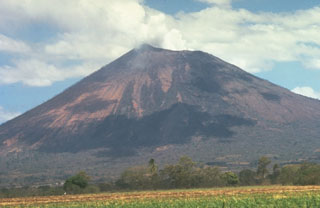Report on San Cristobal (Nicaragua) — 20 April-26 April 2016
Smithsonian Institution / US Geological Survey
Weekly Volcanic Activity Report, 20 April-26 April 2016
Managing Editor: Sally Sennert.
Please cite this report as:
Global Volcanism Program, 2016. Report on San Cristobal (Nicaragua) (Sennert, S, ed.). Weekly Volcanic Activity Report, 20 April-26 April 2016. Smithsonian Institution and US Geological Survey.
San Cristobal
Nicaragua
12.702°N, 87.004°W; summit elev. 1745 m
All times are local (unless otherwise noted)
INETER and SINAPRED reported that at 1020 on 22 April an explosion at San Cristóbal produced an ash-and-gas plume that rose 2 km above the crater and drifted SW. The seismic network recorded 10 additional explosions by 1200. Ashfall was reported in local areas including Las Brisas (10 km S), San José (8 km SSE), Santa Narcisa, Pellizco Central (12 km SSE), Los Ébanos, Los Lirios (18 km WSW), Santa Cruz (35 km SE), Las Grietas (14 km E), El Liberal, and San Lucas (13 km E). The INETER report noted that the last explosive activity occurred on 6 June 2015, though explosions that day were of lesser magnitudes.
Geological Summary. The San Cristóbal volcanic complex, consisting of five principal volcanic edifices, forms the NW end of the Marrabios Range. The symmetrical 1745-m-high youngest cone, named San Cristóbal (also known as El Viejo), is Nicaragua's highest volcano and is capped by a 500 x 600 m wide crater. El Chonco, with several flank lava domes, is located 4 km W of San Cristóbal; it and the eroded Moyotepe volcano, 4 km NE of San Cristóbal, are of Pleistocene age. Volcán Casita, containing an elongated summit crater, lies immediately east of San Cristóbal and was the site of a catastrophic landslide and lahar in 1998. The Plio-Pleistocene La Pelona caldera is located at the eastern end of the complex. Historical eruptions from San Cristóbal, consisting of small-to-moderate explosive activity, have been reported since the 16th century. Some other 16th-century eruptions attributed to Casita volcano are uncertain and may pertain to other Marrabios Range volcanoes.
Sources: Instituto Nicaragüense de Estudios Territoriales (INETER), Sistema Nacional para la Prevención, Mitigación y Atención de Desastres (SINAPRED)

